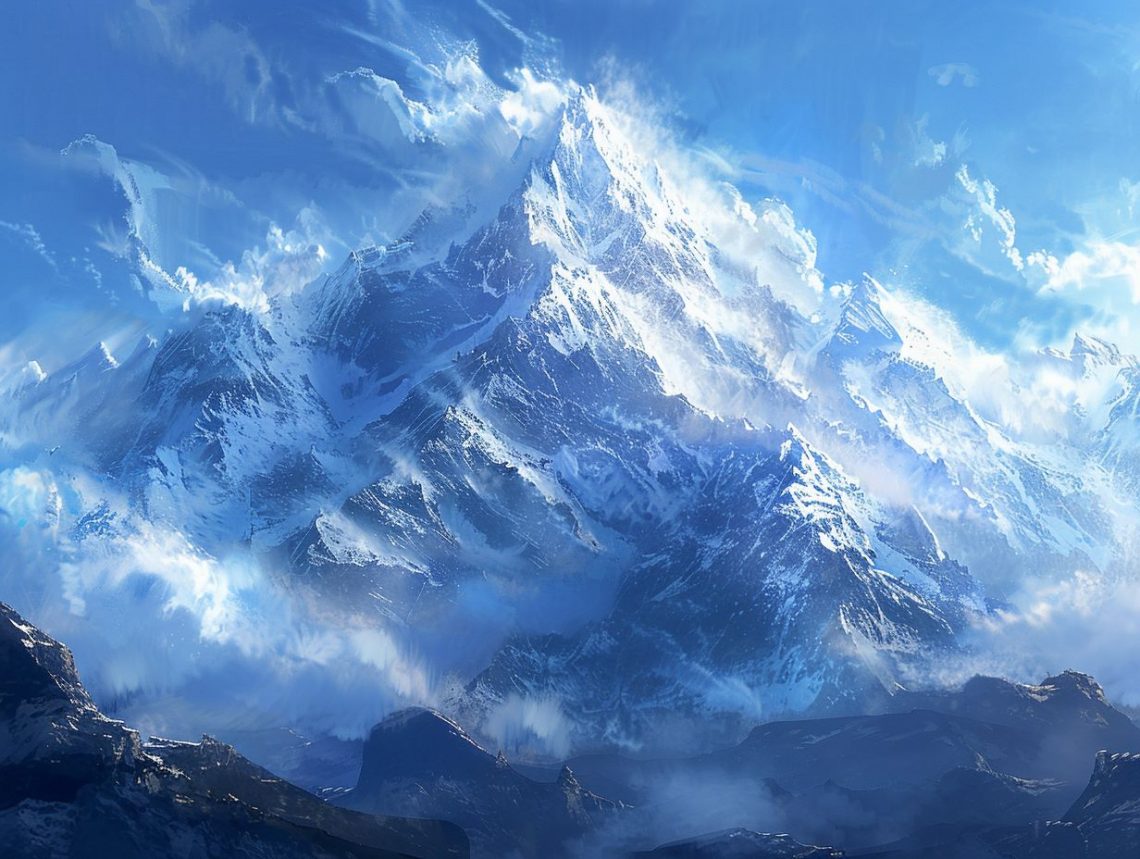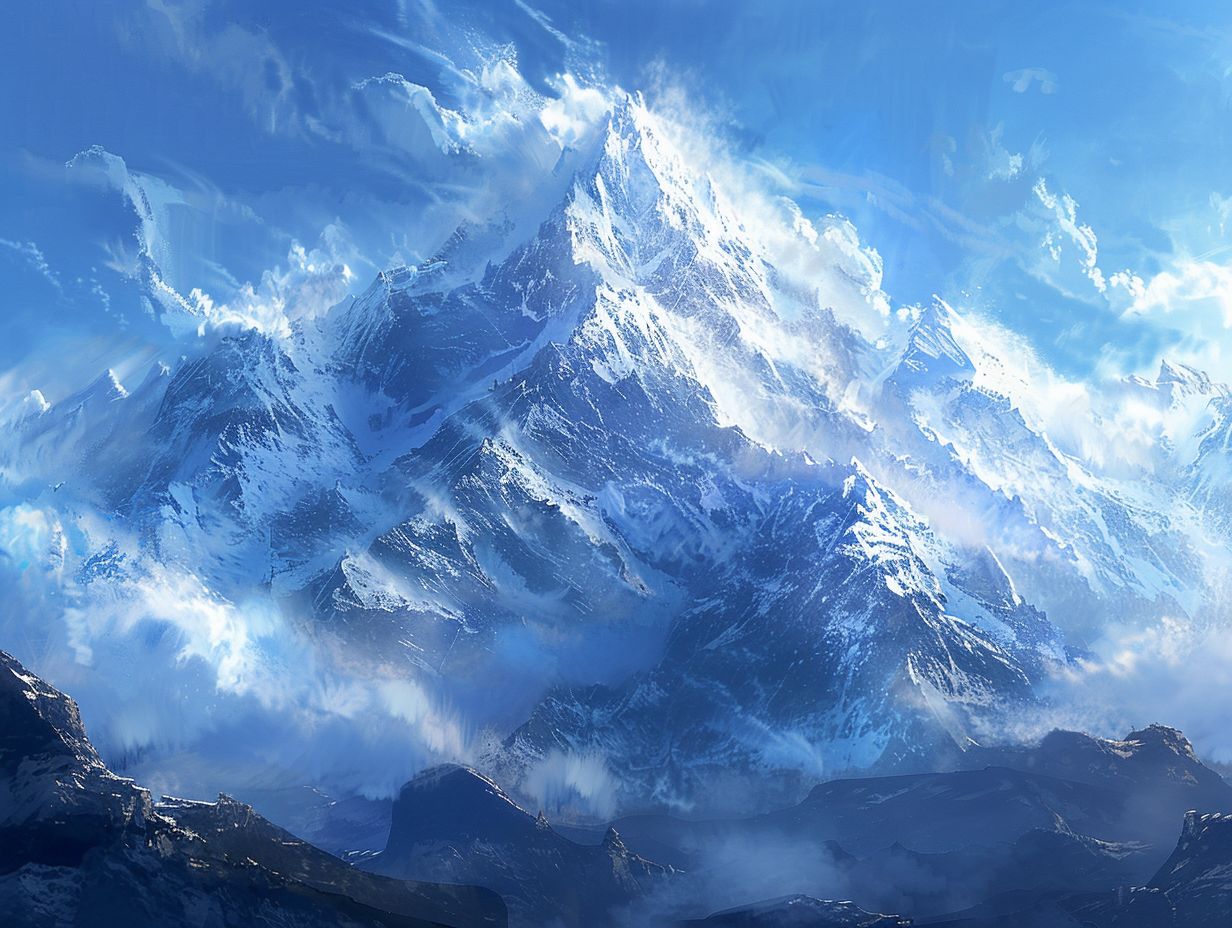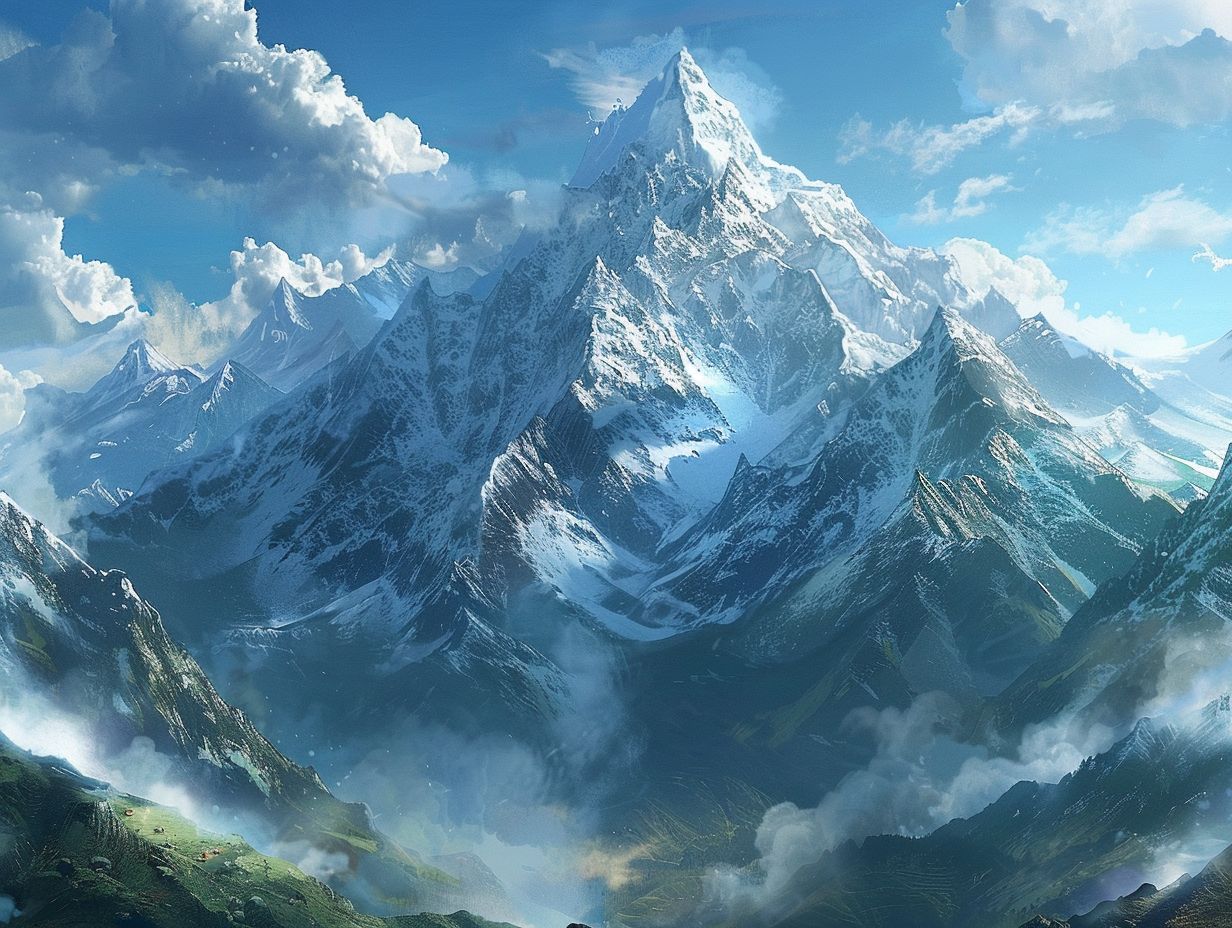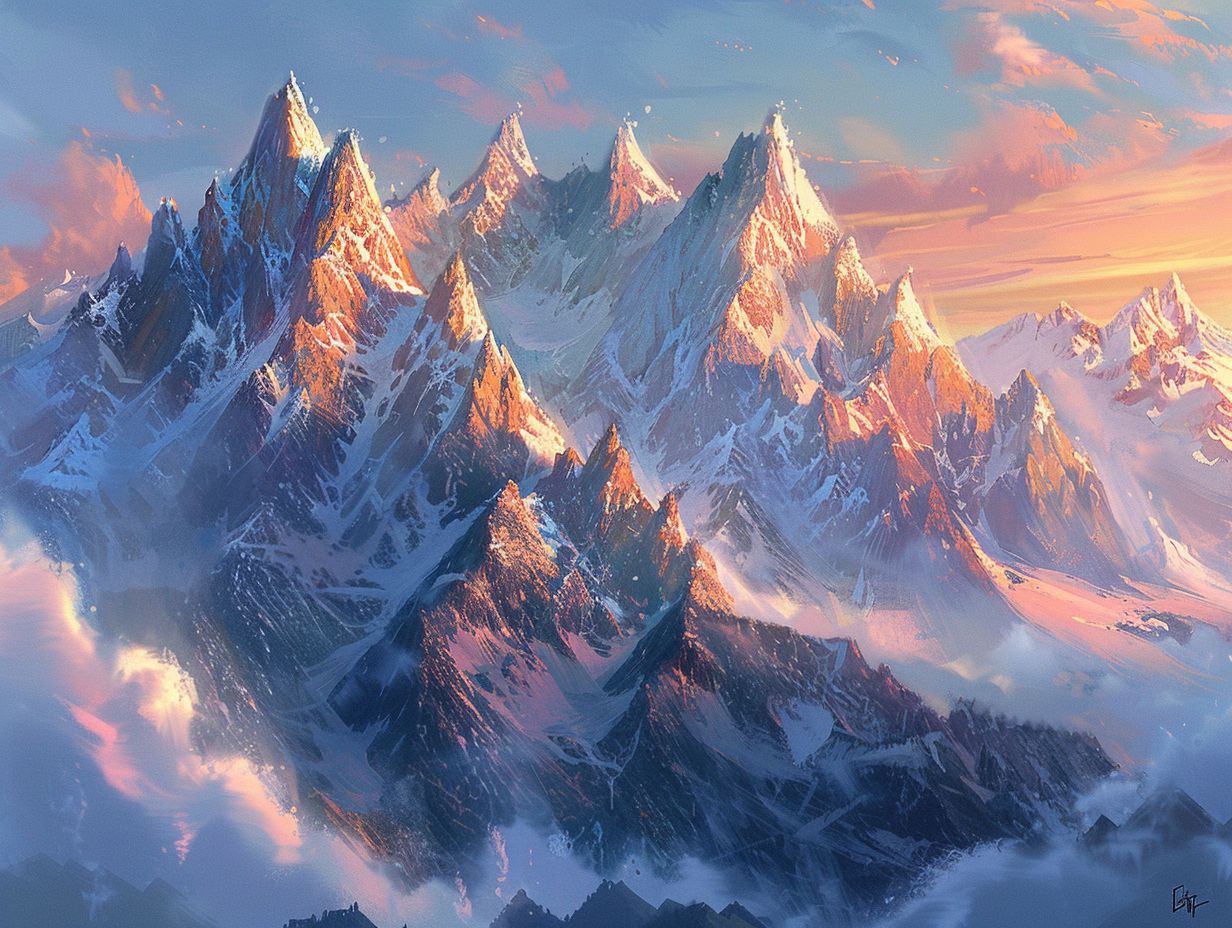
Tallest Mountains In The World
Have you ever wondered what makes a mountain the tallest? Is it all about height or does elevation play a role as well?
In this article, we will explore the top 5 tallest mountains in the world, including Mount Everest and K2. We will also take a look at other notable tallest mountains like Cho Oyu and Annapurna.
We will discuss the challenges of climbing these towering peaks, from altitude sickness to harsh weather conditions.
Stay tuned to learn about famous mountaineers and their remarkable achievements in conquering these majestic mountains.
Key Takeaways:

- The height of a mountain is determined by its elevation, not just its height above sea level.
- The top 5 tallest mountains in the world are Mount Everest, K2, Kangchenjunga, Lhotse, and Makalu.
- Challenges of climbing the tallest mountains include altitude sickness, harsh weather conditions, and technical difficulty.
What Makes a Mountain the Tallest?
Understanding what makes a mountain the tallest involves considering various factors such as elevation, topographic prominence, and its location within mountain ranges.
1. Height vs. Elevation
The distinction between a mountain’s height and elevation is critical in determining its prominence and significance. Mount Everest, known for its extraordinary altitude, stands as a prime example of this differentiation.
Height refers to the distance between the base and the summit of a mountain, while elevation is the vertical distance above a reference point, usually sea level.
Mount Everest, with a height of 29,032 feet and an elevation of 29,032 feet, showcases this disparity.
Mountains like Everest, with their towering heights, captivate climbers and explorers worldwide, embodying a sublime connection between the earth and the sky.
The altitude of such colossal peaks not only challenges human endurance but also symbolizes the resilience and grandeur of nature’s creations, inspiring awe and admiration.
Top 5 Tallest Mountains in the World
Exploring the list of the top 5 tallest mountains in the world reveals iconic peaks like K2 and Denali, showcasing the grandeur of the eight-thousanders found in Central and South Asia.
1. Mount Everest
Mount Everest, situated on the border between Nepal and China, stands as the highest point on Earth, attracting climbers worldwide in pursuit of conquering it’s magnificent summit.
Towering at an elevation of 29,032 feet above sea level, this legendary peak is part of the majestic Himalayas, known for its unpredictable weather and treacherous terrain.
Notable summits like the South Col and the North Ridge challenge experienced climbers, while the infamous Khumbu Icefall poses a deadly obstacle.
Mount Everest holds cultural significance for the Sherpa people of the region, who revere the mountain as Sagarmatha in Nepal and Chomolungma in Tibet.
2. K2
K2, known for its challenging terrain and formidable altitude, has garnered a reputation as a peak that tests the limits of even the most experienced climbers.
K2, also named Mount Godwin-Austen, stands at a towering 8,611 meters, making it the second-highest mountain in the world, topped only by Mount Everest.
What sets K2 apart is its steep and icy slopes that demand technical climbing skills and nerves of steel.
The unpredictable weather conditions, including ferocious winds and sudden storms, add to the risk factor, turning expeditions into life-or-death endeavors.
Many climbers have faced tragic fates on K2, earning it the ominous title of the ‘Savage Mountain’ among the mountaineering community.
3. Kangchenjunga
Kangchenjunga, with its majestic presence and location amidst mountain islands, epitomizes the allure of volcanic mountains in the Himalayan region.
Located on the border between Nepal and the Indian state of Sikkim, Kangchenjunga stands as the third highest mountain in the world, boasting an elevation of 8,586 meters.
It’s name translates to ‘Five Treasures of Snow’, reflecting the five peaks that make up its summit.
These towering peaks, shrouded in mystery and legend, contribute to the mountain’s spiritual significance in local culture.
Volcanic in origin, Kangchenjunga’s formation dates back millions of years, sculpted through intense geological processes.
This geological history lends a distinctiveness to its landscape, with deep valleys, steep ridges, and stunning glaciers encapsulating its grandeur.
4. Lhotse
Lhotse, a neighboring peak to Mount Everest, presents a formidable challenge to climbers with its steep faces and high altitude.
Standing at an impressive 8,516 meters, Lhotse is the fourth highest peak in the world, attracting elite climbers seeking the next level of challenge after conquering Everest.
The proximity to Mount Everest adds another layer of complexity to the expedition, with climbers often experiencing harsh weather conditions.
The altitude-related obstacles on Lhotse test climbers’ endurance, mental resilience, and physical fitness, as they grapple with acclimatization issues.
Despite these challenges, reaching the summit of Lhotse rewards climbers with breathtaking panoramic views of the Himalayas and an unparalleled sense of accomplishment.
5. Makalu

Makalu’s soaring altitude and rugged terrain attract intrepid climbers seeking to test their skills against one of the tallest summits on Earth.
The allure of Makalu’s altitude lies not only in its height but also in the challenging landscape that surrounds it.
Climbers are drawn to the steep ridges, imposing cliffs, and unpredictable weather conditions that define this remarkable peak.
The experiences of those who summit Makalu are often filled with a mix of awe and adrenaline as they navigate through ice fields, crevasses, and icy slopes.
Other Notable Tallest Mountains
While Mount Everest and K2 dominate the list of the tallest mountains, other notable peaks like Aconcagua in the Rocky Mountains also boast remarkable topographic prominence, attracting adventurers and climbers.
1. Cho Oyu
Cho Oyu, with its breathtaking altitude and challenging summits, presents climbers with a formidable yet rewarding expedition.
At 8,188 meters, Cho Oyu stands as the sixth-highest peak in the world, located in the Himalayas on the Nepal-Tibet border.
It’s name translates to ‘Turquoise Goddess’ in Tibetan, reflecting the stunning glacial ice on its slopes.
Climbers are drawn to the peak not only for its majestic beauty but also for the technical skill and physical endurance required to navigate its icy terrain.
The experience of summiting Cho Oyu is a blend of awe-inspiring views and the sheer adrenaline rush of overcoming extreme altitudes and unpredictable weather conditions.
2. Dhaulagiri
Dhaulagiri, standing tall with its awe-inspiring altitude and unique geographical distribution, captures the attention of mountaineers and adventurers alike.
Located in the central part of the Nepal Himalayas, Dhaulagiri is the seventh highest mountain on Earth, towering at an elevation of 8,167 meters.
It’s name translates to ‘White Mountain’, reflecting the snow-covered peaks that dominate it’s rugged terrain. The massif extends over 120 km with several awe-inspiring ridges and valleys surrounding its base.
This massive peak contributes to the breathtaking panorama of the Annapurna range, offering a stunning backdrop to the picturesque landscape of the region.
The Dhaulagiri Base Camp provides a strategic vantage point for adventurers to embark on challenging expeditions to conquer this majestic summit.
3. Manaslu
Manaslu, nestled in the heart of Nepal, beckons climbers with its formidable altitude and awe-inspiring vistas, offering a challenging yet rewarding ascent.
Located in the Gorkha district of Nepal, Manaslu stands tall at an impressive 8,163 meters above sea level, making it the eighth highest mountain in the world.
Climbers are drawn to its remote and pristine setting, away from the crowded trails of Everest and Annapurna. As they embark on their journey, they navigate through a variety of terrain
The climbers’ experience is characterized by a test of physical endurance and mental resilience, facing unpredictable weather conditions.
Acute altitude sickness poses a significant risk, requiring climbers to acclimatize carefully to prevent serious health complications.
4. Nanga Parbat
Nanga Parbat, known for its steep faces and formidable altitude, presents climbers with a challenging yet rewarding endeavor.
5. Annapurna
Annapurna, with its majestic altitude and rugged terrain, stands as a testament to the challenges and rewards of high-altitude mountaineering.
The allure of Annapurna lies not only in its impressive height but also in its unpredictable and often harsh weather conditions that test the resilience.
Mountaineers are lured by the sheer size and beauty of the mountain, as well as the technical difficulties that come with navigating its steep slopes and icy crevasses.
Challenges of Climbing the Tallest Mountains
Embarking on the journey to conquer the tallest mountains presents climbers with a myriad of challenges, from battling altitude sickness to navigating harsh weather conditions.
1. Altitude Sickness

Altitude sickness poses a significant threat to climbers scaling the tallest mountains, with symptoms ranging from nausea and dizziness to more severe conditions.
As climbers ascend to higher altitudes, the reduced oxygen levels can lead to altitude sickness, also known as acute mountain sickness (AMS).
This condition can manifest with symptoms such as headaches, fatigue, and difficulty sleeping.
In severe cases, climbers may experience pulmonary edema or cerebral edema, which are life-threatening conditions requiring immediate descent to lower altitudes for treatment.
2. Harsh Weather Conditions
Navigating the unpredictable and often treacherous weather conditions prevalent on the tallest mountains requires climbers to exercise caution, preparedness, and resilience.
During their ascent, climbers must contend with a multitude of adverse weather patterns ranging from blinding snowstorms.
- Extreme cold temperatures can lead to frostbite and hypothermia, emphasizing the crucial need for appropriate clothing and gear.
- High-altitude winds pose a significant risk, threatening to knock climbers off balance and increasing the chances of accidents.
- Heavy precipitation such as snow or rain can create slippery and unstable terrain, making progress slow and hazardous.
Comprehensive understanding of weather patterns and the ability to adapt swiftly are essential skills for climbers negotiating these formidable challenges.
3. Technical Difficulty
Confronting the technical complexities of the terrain and conditions on the tallest mountains demands climbers to leverage advanced technologies.
These climbers face numerous obstacles while pushing their physical and mental limits to reach the summit.
At high altitudes, where oxygen levels are significantly reduced, climbers need specialized breathing apparatus like oxygen tanks to prevent altitude sickness and hypoxia.
The extreme cold temperatures can lead to frostbite, making it crucial for climbers to have insulated gear and proper clothing to stay warm.
In addition, the rugged terrain and unpredictable weather conditions necessitate the use of advanced navigation tools such as GPS devices and satellite communication.
Famous Mountaineers and their Achievements
Celebrated mountaineers like Sir Edmund Hillary, Tenzing Norgay, Reinhold Messner, and Junko Tabei have etched their names in history through remarkable achievements in conquering some of the world’s highest peaks, inspiring generations with their courage and tenacity.
1. Sir Edmund Hillary and Tenzing Norgay
Sir Edmund Hillary and Tenzing Norgay’s historic ascent of Mount Everest in 1953 marked a monumental achievement in the realm of mountaineering.
Their expedition, organized by the Royal Geographical Society and the Alpine Club, unfolded against a backdrop of extreme physical and psychological hurdles.
The treacherous terrain, bone-chilling temperatures, and unpredictable weather conditions posed formidable obstacles every step of the way.
Mount Everest, with its towering presence and unforgiving nature, challenged the very limits of human endurance.
Their triumph not only showcased unparalleled determination but also fostered a new era of mountaineering exploration.
2. Reinhold Messner
Reinhold Messner, renowned for his daring exploits in high-altitude mountaineering, pushed the boundaries of what was deemed possible.
His relentless pursuit of conquering uncharted terrains led him to achieve monumental feats that etched his name in the annals of mountaineering history.
Messner’s uncanny ability to navigate through treacherous landscapes and extreme weather conditions set him apart from his contemporaries.
His expeditions to the Himalayas and the Karakoram range became the stuff of legends, with each successful summit further solidifying his reputation.
Reinhold not only conquered peaks but also revolutionized the approach to high-altitude climbing, introducing innovative techniques and equipment.
3. Junko Tabei
Junko Tabei’s trailblazing ascent of Mount Everest as the first woman to reach the summit, inspiring a new generation of female climbers.
Her accomplishment shattered gender norms in this traditionally male-dominated realm and paved the way for other women to defy societal expectations.
Tabei’s unwavering determination and unwavering courage in the face of extreme challenges have left an indelible mark on the history of mountaineering.
Mount Everest, the ultimate symbol of human endurance and triumph over nature’s formidable obstacles, holds a special place in the hearts of climbers worldwide.
Tabei’s legacy continues to inspire climbers globally, reminding them that perseverance and grit can conquer even the most formidable peaks.
4. Krzysztof Wielicki
Krzysztof Wielicki’s legendary climbs of some of the world’s tallest peaks, characterized by his unmatched altitude feats and unwavering determination.
Wielicki’s expedition history includes groundbreaking achievements like being the first person to summit Lhotse in the winter, further solidifying his reputation.
His daring ascents on K2 and Everest showcased not only his physical prowess but also his strategic brilliance in navigating treacherous conditions.
Despite facing severe weather conditions, oxygen depletion, and crevasse dangers, Wielicki’s unwavering spirit and meticulous planning allowed him to conquer these formidable peaks.
His contributions to the field, spanning decades, have inspired generations of climbers and continue to shape the future of high-altitude mountaineering.
5. Gerlinde Kaltenbrunner

Gerlinde Kaltenbrunner’s unparalleled feats in conquering the world’s highest peaks, underscore her exceptional skill and determination as an accomplished mountaineer.
Having scaled all 14 peaks over 8,000 meters without supplemental oxygen, Gerlinde Kaltenbrunner solidified her place in mountaineering history.
Her expeditions to the treacherous K2, the notorious Nanga Parbat, and the challenging Mount Everest exemplify her unwavering bravery and expertise.
Facing extreme weather conditions and high-altitude sickness, she navigated through each obstacle with remarkable resilience and strategic planning.
Frequently Asked Questions
1. What are the top three tallest mountains in the world?
A: The top three tallest mountains in the world are Mount Everest, K2, and Kangchenjunga.
2. How tall is Mount Everest, the tallest mountain in the world?
A: Mount Everest is 8,848 meters (29,029 feet) tall.
3. Which continent is home to the most of the tallest mountains in the world?
A: Asia is home to the most of the tallest mountains in the world, including Mount Everest, K2, and Kangchenjunga.
4. What is the highest mountain range in the world?
A: The highest mountain range in the world is the Himalayas, which includes Mount Everest and several other of the tallest mountains in the world.
5. How many of the top 10 tallest mountains in the world are located in Nepal?
A: Eight of the top 10 tallest mountains in the world are located in Nepal, including Mount Everest, the tallest of them all.
6. What is the best time of year to climb the tallest mountains in the world?
A: The best time of year to climb the tallest mountains in the world is typically during the spring season (April-May) when the weather is milder and there is less chance of snowfall. However, this can vary depending on the specific mountain and weather conditions.